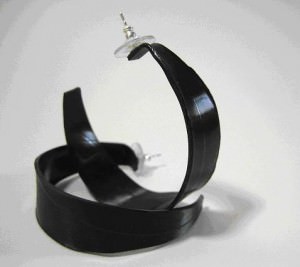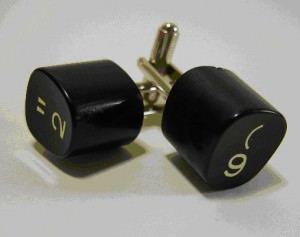A Crafty Business Model – Misssoka’s Take on All Things Eco
An exclusive interview with Misssoka, trendy entrepreneurs crafting chic, eco-friendly products.
By Lisa Sookraj, Staff Writer
“It can sometimes be challenging to work in an eco-angle when designing, unable to predict the availability of certain materials, working in limited runs, but it just means our creative selves are pushed.”
 Everything is going green – often at the cost of more green – these days. Which is why I chose to approach design duo Misssoka to discuss their affordable, “salvagewear” jewelry made from found materials and their transition from studio art majors to business-savvy entrepreneurs, who have managed to turn their love of fashion and thrifting into something profitable. Misssoka consists of Dana Dal Bo, who is about to pursue an MFA in Fibres, and MaryAnne Petrella, who currently writes for interior design blog ReNest. Both obtained their BFA degrees from Concordia University in Montreal.
Everything is going green – often at the cost of more green – these days. Which is why I chose to approach design duo Misssoka to discuss their affordable, “salvagewear” jewelry made from found materials and their transition from studio art majors to business-savvy entrepreneurs, who have managed to turn their love of fashion and thrifting into something profitable. Misssoka consists of Dana Dal Bo, who is about to pursue an MFA in Fibres, and MaryAnne Petrella, who currently writes for interior design blog ReNest. Both obtained their BFA degrees from Concordia University in Montreal.
The Interview:
LS: How did Misssoka start out?
Misssoka: Quite often, we would often go out thrift shopping together and noticed that we had very similar tastes. We eventually amassed so many strange and wonderful things that they just had to be put to good use! Much of what we collected was small and in multiples, so creating jewelry seemed natural. In 2005, we created the Misssoka label.
[pullquote]It can sometimes be challenging to work in an eco-angle when designing, unable to predict the availability of certain materials, working in limited runs, but it just means our creative selves are pushed.[/pullquote]Our first public venture was at an indie-craft fair and, fortunately for us, the community was very supportive. During the event, we were approached by the owner of a popular Montreal boutique and that really solidified the notion that Misssoka had potential.
LS: Tell us about how you’ve made your business profitable.
Misssoka: It’s always challenging to find stores with the ability to invest outright in a product – particularly these days. We’ve found that consignment arrangements are an ideal solution, so this is how most of our business is conducted with our retailers. While it does require extra organization from both the vendor and retailer, this model allows for a greater amount of merchandise to be sold through a store because of the increased selection. It also allows us to make sure the shops have enough of what sells well for them. Having a firm handle on what the store receives and when can help maintain and increase sales momentum.
LS: What do you find attractive about the whole eco trend?
Misssoka: For a long time, the term “eco” conjured up images of hippy communes and tie-dye as far as the eye can see. This is far from the case these days. Misssoka is part of a movement where sustainability and fashion share equal representation. It can sometimes be challenging to work in an eco-angle when designing, unable to predict the availability of certain materials, working in limited runs, but it just means our creative selves are pushed.
 LS: Is eco a trend or is it the future?
LS: Is eco a trend or is it the future?
Misssoka: It’s both. Right now it seems everything is proudly selling its “green” angle to be on trend. Companies are aware that this is what consumers want. Because of this shift in consumer expectation, the idea of “green” as a trend will inevitably turn into sustainable production as the norm, at least in the West.
Of course, there will always be goods created in unsustainable ways, but many industries are now seeing how the concept of sustainability offers positive benefits both environmentally and economically. Eco means more than just recycling or repurposing materials; it is about considering the means of productions and the life cycle of a product. Our Heirloom collection isn’t traditionally “green,” but the timeless designs are intended to be passed on for generations.
LS: Why do some eco-products cost more?
Misssoka: It has a lot to do with their modes of production. There are fewer shortcuts when things are made sustainably, more man hours at fair wages, more steps in the process, smaller production runs, lack of subsidies, availability of material – all of this can translate into higher costs for the creator and consumer.
It is sometimes hard to negotiate the cost disparities in our heads because it means looking at a bigger picture, but it is well worth it. The more we do, the easier it will be for businesses, big and small, to continue making the shift towards sustainable production. The ball is already rolling – it’s a slow roll, but consumers are beginning to reprioritize; they are starting to appreciate abundant clean water supplies and breathable air more than a killer bargain.
LS: What advice would you give to other young artists/entrepreneurs hoping to see a return from their talents?
Misssoka: Know your industry and communicate with the community. It pays to do a bit of research and to be selective when choosing venues. You can make more money in less time at a carefully selected, well-promoted event. And whatever the entrepreneurial endeavour, get out there and talk to the people who are doing it with some measure of success.
Granted the eco-craft community is a pretty friendly and generous bunch, but a few short conversations have saved us applying to poorly managed events, and directed us to the best suppliers, retail opportunities and more. Aside from networking, seek out the help that is available to you through government programs or NPOs, like Youth Employment Services (YES) Montreal.
There is a wealth of knowledge and resources available, often at no charge, to help your venture succeed.
To check out Misssoka’s line of unconventional jewelry, check out http://misssoka.com/
ARB Team
Arbitrage Magazine
Business News with BITE.
Liked this post? Why not buy the ARB team a beer? Just click an ad or donate below (thank you!)
Liked this article? Hated it? Comment below and share your opinions with other ARB readers!






























Share the post "A Crafty Business Model – Misssoka’s Take on All Things Eco"